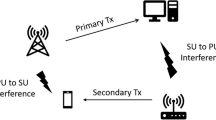Abstract
Cognitive Radio (CR) approach can be considered as a promising and suitable solution to solve in an efficient and flexible way the increasing and continuous demand of services and radio resources. This paper shows the potential benefits of the adoption of a cognitive radio strategy to the coexistence problem. Two different approaches have been considered: the first one is based on the Game Theory while the second one is formalized as a constrained maximum search and represent the optimum solution. The Game theory approach, suitable for a distributed implementation, provides performances comparable to the heuristic one which is a centralized optimization problem. The paper analyzes the performances of both approaches in terms of secondary rates and spectral efficiency provided by the secondary system.
Similar content being viewed by others
Abbreviations
- BER:
-
Bit error rate
- CR:
-
Cognitive radio
- ETSI:
-
European telecommunications standard institute
- DVB-SH:
-
Digital satellite video broadcasting—Satellite services to handhelds
- FCC:
-
Federal communications commission
- PDF:
-
Probability density function
- OFDM:
-
Orthogonal frequency division multiplexing
- QAM:
-
Quadrature amplitude modulation
- QPSK:
-
Quadrature phase shift keying
- SINR:
-
Signal to noise and interference ratio
References
Mitola, J., III, & Maguire, G. Q. Jr. (1999). Cognitive Radio: Making software radios more personal. IEEE Personal Communications, 6,4, 13–18.
FCC Spectrum Policy Task Force. (2002). Report of the spectrum efficiency working group, November 2002.
ETSI. (2008). Digital Video Broadcasting (DVB); Framing structure, channel coding and modulation for Satellite Services to handheld devices (SH) below 3GHz. EN 302 583, v1.1.1, March 2008.
Lutz E., Cygan D., Dippold M., Dolainsky F., Papke W. (1991) The land mobile satellite communication channel-recording, statistics, and channel model. IEEE Transactions on Vehicular Technology 40(2): 375–386
Del Re, E., Argenti, F., Ronga, L. S., Bianchi, T., & Suffritti, R. (2008). Power allocation strategy for Cognitive Radio terminals. In Proceedings on cognitive radio and advanced spectrum management, CogART 2008, First International Workshop on, Aalborg, Denmark, pp. 1–5.
Monderer D., Shapley L.S. (1996) Potential games. Games and Economic Behavior 14(1): 124–143
MacKenzie, A. B., & DaSilva, L. A. (2006). Game theory for wireless engineers (Synthesis Lectures on Communications), Morgan & Claypool Publishers.
Author information
Authors and Affiliations
Corresponding author
Rights and permissions
About this article
Cite this article
Del Re, E., Gorni, G., Ronga, L.S. et al. Resource Allocation in Cognitive Radio Networks: A Comparison Between Game Theory Based and Heuristic Approaches. Wireless Pers Commun 49, 375–390 (2009). https://doi.org/10.1007/s11277-009-9689-0
Received:
Accepted:
Published:
Issue Date:
DOI: https://doi.org/10.1007/s11277-009-9689-0




